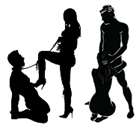| Navigation |
|---|
|
|
|

|
|
|
The Physiology of Pleasure |
 Sexual
pleasure involves a lot more than just what's in your -- or your friend's --
pants, but getting to know "the lay of the land" sure doesn't hurt. The truth
is, we can experience more pleasure in our sexual encounters if we're better
informed about genital sensation. Here are a couple of maps to get you started. Sexual
pleasure involves a lot more than just what's in your -- or your friend's --
pants, but getting to know "the lay of the land" sure doesn't hurt. The truth
is, we can experience more pleasure in our sexual encounters if we're better
informed about genital sensation. Here are a couple of maps to get you started.
Appearance
Genitalia -- female, male, transgender and intersexed -- all vary greatly in
size, shape, color and response to stimulation. The female external genitalia
are referred to as the vulva. This includes the outer lips (or labia), the inner
lips, the clitoris and the vaginal opening. Men's external genitalia consist of
the penis and scrotum. One to two people out of every thousand are born
intersexed, yet surgeons alter most at birth. These individuals are born with
genetic or hormonal variations that may affect their genitals, gonads and other
characteristics. Intersexed people can have both female and male genitalia in
varying combinations, or genitals that are ambiguous. A transgendered person is
someone born with a body that doesn't accurately reflect the gender they feel
themselves to be, and may possess any of the above sets of genitalia.
Transgendered and intersexed folks may name or define their genitalia in any way
they feel is accurate. We're all born with bundles of nerve endings in different
packages -- how we think of them, what we do with them, and what feels great
varies according to the individual.
Some transgendered people choose to pursue hormone therapy and/or sexual
reassignment surgery. In male-to-female surgery, the penis is turned inside out
so that the walls of the vagina are the former penis shaft, and the sensitive
corona of the penis is used to create the clitoris. At present, female-to-male
transsexuals can choose between two operations: phalloplasty and metoidioplasty.
In phalloplasty a penis is surgically constructed from skin grafts and the
clitoris is left at the base of the new penis (above the scrotum) to allow for
sexual stimulation. Metoidioplasty involves releasing the testosterone-enlarged
clitoris from its hood and creating a scrotum out of the labia majora. The
resulting penis can be smaller than one built through phalloplasty but retains
sensitivity, whereas a penis created through skin grafts can have limited
sensation. Hormones can be taken before or after surgery, and some folks opt to
take hormones and have no surgery. The introduction of new hormones into a body
causes a variety of physiological changes, including enlargement of the clitoris
and shrinkage of the breasts (female to male) and enlargement of the breasts
with shrinkage of the penis (male to female). While some transsexual and
transgendered people may experience a reduction of sex drive when they begin to
take hormones, others will find that their level of arousal increases sharply.
Often, these changes in sex drive occur in the first few years of hormone
therapy, with the changes leveling out over time.
Pleasure inside the body
The walls of the vagina rest against each other most of the time, yet when
aroused can expand to varying degrees to accommodate what feels best, from
fingers to large dildos. The outer third is more sensitive than the rest of the
vagina and responds well to friction and vibration; the inner two-thirds are
smoother, contain fewer nerve endings and are more responsive to pressure and
motion. When stimulated the vagina usually self-lubricates; however, lubrication
should not necessarily be measured as a sign of arousal, since a woman's natural
lubrication can vary for many reasons.
The base of the penis extends inside the body, and pressing your fingers against
the area between testicles and anus you can feel the root, or bulb. This area
can be pleasurable to touch and is stimulated either through the skin or from
within the anus.
G-spot, prostate and ejaculation
The G-spot is the spongy, ridged area on the front wall of the vagina (towards
the bellybutton). It is loaded with nerve endings and is an erogenous zone for
many women -- yet for some, stimulation of this area may be irritating and
unpleasant. The G-spot can best be massaged by inserting a finger, penis or
curved sex toy two to three inches into the vagina and stroking towards the
front of the body with a "come hither" motion. Some women require quite a bit of
pressure; it helps to use a lubricant so the pressure does not feel irritating.
Of those who greatly enjoy this type of stimulation, some women experience an
ejaculation of fluid upon orgasm or as part of arousal. This fluid is a product
of the paraurethral sponge, is clear and odorless, and should not be confused
with urine.
In the male, the prostate gland is comparable to the G-spot. The prostate is an
internal organ that produces ejaculatory fluid and is tucked close to the root
of the penis. Ejaculation is often considered the same as orgasm, yet some men
can have orgasms without releasing ejaculatory fluid, and vice-versa. The
prostate is a source of great pleasure for many men -- some have orgasms from
its stimulation alone -- and it can be used to enhance genital stimulation,
though for some this may feel unpleasant. The prostate can best be massaged by
inserting a finger two to three inches into the anus and stroking towards the
front of the body with a "come hither" motion, exactly as you would for a G-spot
stroke within the vagina. When aroused, the prostate swells and hardens,
becoming more receptive to firm stimulation.
Anal pleasure
The anus, richly endowed with nerve endings, is the closest erogenous neighbor
of the genitals and contracts rhythmically during orgasm. Stimulating the anus
can indirectly stimulate the penile or clitoral legs (see below), or can
directly stimulate the prostate gland. Inside, there are two sphincter muscles.
The external muscle can be tensed at will, while the internal muscle can tense
automatically, even if you are trying to relax. When stimulating the anus use
plenty of lubrication and go very slowly, always listening to the feedback of
the person who is being penetrated. With the anus there are particular safety
concerns. Rectal tissue is very thin and does not self-lubricate, so it can tear
easily (make sure to use lots of lube), and it's important not to insert
anything that might break or have sharp edges. Also, the involuntary expanding
and contracting of the sphincter muscle can quickly pull in (as well as push
out) anything you're inserting, so be sure that the item you use has a flared
base to prevent it from "getting lost" in the anal canal. Not everyone enjoys
anal stimulation, but those who do find it adds an extra dimension to their
sexual repertoire.
External touching and masturbation
The clitoris and head of the penis contain concentrated bundles of nerve endings
that respond pleasurably to touch and other types of stimulation. The clitoris
is tucked under folds of skin where the top of the labia meet, and pulling back
the skin will usually reveal what is referred to as the clitoral glans, or head.
(In some women the glans is obscured by the hood.) The visible part of the
clitoris is just the tip of the iceberg. Directly beneath the surface of the
glans is something that feels like a short rod of cartilage. This is the
clitoral shaft. Inside the body, the clitoral shaft separates into two legs that
extend in a wishbone fashion for about three inches on either side of the
vaginal opening. The entire clitoris consists of erectile tissue just like the
erectile tissue of the penis. During sexual arousal the tissue fills with blood,
and the glans, shaft and legs swell, becoming firm and sensitive. In many cases
the swelling -- or erection -- of the clitoris is visible. Because of the
internal position of the legs, when you stimulate the urethra, vagina or anus,
you indirectly stimulate the clitoris as well.
The head of the penis (also called the glans) is more sensitive than the shaft,
particularly the ridge around the base. The coronal ridge is comparable to the
tip of the clitoris. Spongy erectile tissue and blood vessels run the length of
the penis, and extend into the body. These separate into two legs, comparable to
the legs of the clitoris. During sexual arousal erection may occur when this
tissue fills with blood and the penis swells, becoming more firm and sensitive.
Erection, however, is not always a measure of arousal. All men are born with a
foreskin, a retractable nerve-rich hood covering the head of the penis. Some men
are circumcised, meaning that this skin covering has been cut off. Since an
uncircumcised glans is protected by a foreskin, it is usually more sensitive
when exposed. Stimulation of the foreskin itself can be very pleasurable. Some
men find stimulation of the urethral opening -- where urine comes out --
pleasant, while others find it irritating. When a man is aroused, the urethral
opening can lubricate itself with a clear substance called pre-ejaculate. The
ridge of skin running from the underside of the head, down the shaft and along
the middle of the scrotum to the anus is also sensitive to touch, and touching
here can be quite pleasurable.
The scrotum is the loose sac of skin and muscle hanging below the penis,
containing the testicles. The testicles are very sensitive, and though even
light tapping on them may be painful, for some men firm pressure, steady pulling
or squeezing the scrotum can feel good.
Many folks learn their capacity for pleasure and orgasm by investigating what
feels good when they touch themselves. What feels right at a particular time or
age may change, and masturbation techniques can be explored throughout the
course of our lifetimes. No matter the physical stage of the individual, all
people can have rewarding sex lives whether solo or partnered.
|
|
|
|
|

